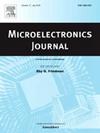Analysis and prediction of bending-torsion coupled stress in BGA stacked solder joints considering interaction effects
IF 1.9
3区 工程技术
Q3 ENGINEERING, ELECTRICAL & ELECTRONIC
引用次数: 0
Abstract
A finite element model of BGA stacked solder joints was established, and finite element simulation analysis of bending-torsion coupled stress and strain was conducted. A testing platform for measuring bending-torsion coupled strain was constructed to validate the accuracy of the simulation. The solder joint diameter, pad diameter, and solder joint height were selected as influencing factors, and an orthogonal table considering the interactions between these factors was designed and established. The maximum bending-torsion coupled stress for 18 different combinations of structural parameter levels in BGA stacked solder joints was obtained, and range and variance analyses of the stress were performed. A multiple nonlinear regression prediction model for the bending-torsion coupled stress of BGA stacked solder joints was established. The results indicate that the order of influence of the factors and their interactions on the bending-torsion coupled stress of BGA stacked solder joints is as follows: solder joint diameter pad diameter solder joint height interaction between pad diameter and solder joint height interaction between solder joint diameter and solder joint height interaction between solder joint diameter and pad diameter. At a confidence level of 99%, the solder joint diameter, pad diameter, and solder joint height have a significant effect on the bending-torsion coupled stress of BGA stacked solder joints, while the interactions among these three structural parameters have an insignificant effect on the bending-torsion coupled stress. The established multiple nonlinear regression prediction model can accurately predict the bending-torsion coupled stress of BGA stacked solder joints, with a maximum error of 2.47% and an average error of 0.95% for the mathematical model.
考虑相互作用的BGA堆叠焊点弯曲-扭转耦合应力分析与预测
建立了BGA堆叠焊点的有限元模型,对其弯曲-扭转耦合应力应变进行了有限元仿真分析。为验证仿真结果的准确性,搭建了弯扭耦合应变测试平台。选取焊点直径、焊盘直径和焊点高度作为影响因素,设计并建立了考虑这些因素相互作用的正交表。得到了18种不同结构参数水平组合下BGA堆叠焊点的最大弯曲-扭转耦合应力,并进行了应力的极差和方差分析。建立了BGA堆叠焊点弯曲-扭转耦合应力的多元非线性回归预测模型。结果表明:各因素及其相互作用对BGA堆叠焊点弯曲扭转耦合应力的影响顺序为:焊点直径>;焊盘直径>;焊点高度>;焊盘直径与焊点高度>;在99%的置信水平下,焊点直径、焊盘直径和焊点高度对BGA堆叠焊点的弯曲-扭转耦合应力有显著影响,而这三个结构参数之间的相互作用对弯曲-扭转耦合应力的影响不显著。所建立的多元非线性回归预测模型能够准确预测BGA堆叠焊点的弯曲-扭转耦合应力,数学模型的最大误差为2.47%,平均误差为0.95%。
本文章由计算机程序翻译,如有差异,请以英文原文为准。
求助全文
约1分钟内获得全文
求助全文
来源期刊

Microelectronics Journal
工程技术-工程:电子与电气
CiteScore
4.00
自引率
27.30%
发文量
222
审稿时长
43 days
期刊介绍:
Published since 1969, the Microelectronics Journal is an international forum for the dissemination of research and applications of microelectronic systems, circuits, and emerging technologies. Papers published in the Microelectronics Journal have undergone peer review to ensure originality, relevance, and timeliness. The journal thus provides a worldwide, regular, and comprehensive update on microelectronic circuits and systems.
The Microelectronics Journal invites papers describing significant research and applications in all of the areas listed below. Comprehensive review/survey papers covering recent developments will also be considered. The Microelectronics Journal covers circuits and systems. This topic includes but is not limited to: Analog, digital, mixed, and RF circuits and related design methodologies; Logic, architectural, and system level synthesis; Testing, design for testability, built-in self-test; Area, power, and thermal analysis and design; Mixed-domain simulation and design; Embedded systems; Non-von Neumann computing and related technologies and circuits; Design and test of high complexity systems integration; SoC, NoC, SIP, and NIP design and test; 3-D integration design and analysis; Emerging device technologies and circuits, such as FinFETs, SETs, spintronics, SFQ, MTJ, etc.
Application aspects such as signal and image processing including circuits for cryptography, sensors, and actuators including sensor networks, reliability and quality issues, and economic models are also welcome.
 求助内容:
求助内容: 应助结果提醒方式:
应助结果提醒方式:


